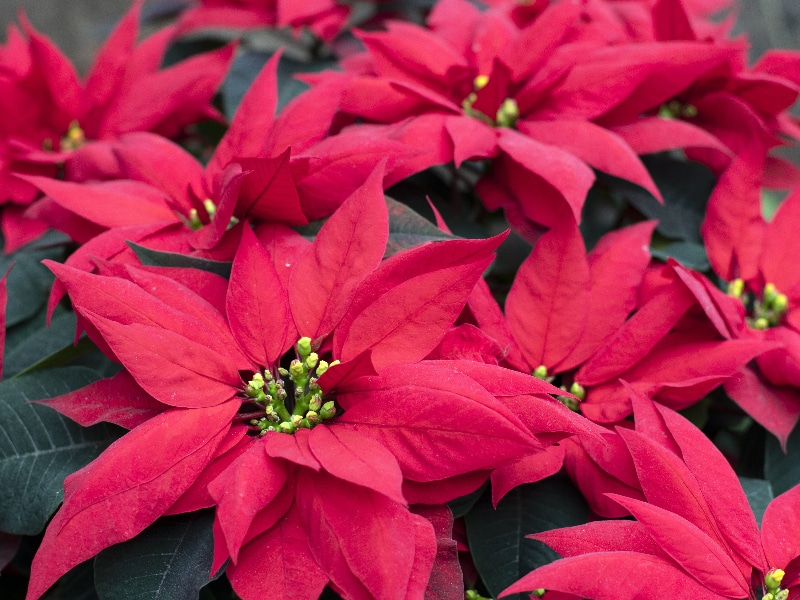Want to know how to pinch back a poinsettia? Read on to find out more.
What comes into your mind when you see poinsettias? You probably didn’t know what they were called, but once you see poinsettias, you’ll instantly be reminded of the holiday season.

Step-By-Step Guide in Pinching Back a Poinsettia
You can see them everywhere during Christmas, but if you want to keep your poinsettias healthy throughout the year, you’ll need to know how to pinch back poinsettias, control soil, water, and temperature conditions.
Here’s a step by step guide on how to pinch back poinsettias:
Step #1: Wear Gloves
Poinsettias produce sap that could irritate the skin. This white sap isn’t poisonous, but it can cause skin irritation, especially if you’re allergic to latex. Make sure to wear gloves when handling poinsettias.
If the sap gets on your skin, immediately rinse it off with soap and water. The sap can also damage your poinsettia plant if you leave it on the leaves and stems for too long. Be sure to wipe the sap off your plant using a damp rag.
Step #2: Cut Dead Leaves
Remove the dead leaves using gardening shears from February to March. Cut off any dry, discolored, or drooping leaves by cutting it on the stem at a 45-degree below the leaf.
Be careful not to cut off healthy leaves. Remember that you may need to disinfect your shear before cutting the leaves to prevent bacteria and diseases from spreading.
Step #3: Trim the Stems
The stems should be around six inches long, so the next step is to trim the stems. Poinsettias can grow into a big shrub. If you want to keep them small, you’ll need to trim the stems.
It’s easier for you to cut the stems after you’re finished with step 2 – removing the dead leaves. You can use the stems to propagate new poinsettias by dipping them in a rooting hormone and then planting them into the soil. For you prefer larger plants, you can leave the stems longer (about eight inches) from the rim of the container or the soil.
Step #4: Prune Poinsettias Often
Your poinsettias will continue to grow after you’ve trimmed the stems. You’ll need to prune them often to keep them at your ideal size.
Check on them at least once a month. If they’ve already grown, trim the stems back to your desired length and you should be left with three to four new leaves. Ideally, your poinsettia plants should appear rounded and have dense growth. Pinching small shoots encourage healthy and plentiful foliage growth.
Step #5: Stop Trimming by November
From the end of the fall season to the beginning of winter, you’ll notice that your poinsettias will begin to bloom and change color. By this time, stop trimming your plants to encourage maximum foliage growth.
Bonus Tip
Poinsettias can survive the summer heat in most parts of the United States, but the nighttime temperatures should be more than 50 degrees F. As mentioned, you can save your cuttings and root them in vermiculite to grow new poinsettias.
Find a sunny spot in your garden or by the window indoors where the temperature is between 60 to 70 degrees F. At the end of the fall season, your plants should be in total darkness for 12 to 14 hours per night to encourage winter blooming.
Regularly check the soil and only water your plants when the soil is dry. Water poinsettias deeply until the water drains from the holes and throw the water that accumulates at the bottom of the plant saucer to avoid root rot.
Warning
Poinsettias are very sensitive to light and they will not bloom if exposed to even a little bit of light. Be sure not to expose them to streetlights or any light that leaks into the area where you planted your poinsettias because even a little bit of light can prevent them from blooming.
Why Should You Plant Poinsettias in a Mini Greenhouse?
There are several reasons why you should plant poinsettias in a mini greenhouse. Here are some of them:
Prevent pests and diseases from damaging your plants
Poinsettias are susceptible to foliar diseases like botrytis gray mold, powdery mildew, and more. Root diseases like Pythium and Rhizoctonia root rot can also form.
If left unattended, insects like whiteflies, mealybugs, thrips, and mites can attack your plants. Growing your poinsettias in an enclosed space and regularly monitoring them reduces the risk of attracting diseases and pests.
Protect your plants from bad weather
Mini greenhouses are also effective in shielding your plants from bad weather. Heavy rain, frost, and extreme weather conditions can greatly damage your plants.
Placing them inside a greenhouse protects your plants from unpredictable weather. Once the weather gets better, you can transplant them outside.
Final Thoughts on How to Pinch Back a Poinsettia
So, how to pinch back a poinsettia? Poinsettias are a staple during the Christmas season. If you want your poinsettias to bloom beautifully in the fall to the winter season, be sure to pinch them back. Pruning and pinching encourage lush foliage growth, allowing you to enjoy beautiful blooms during the holiday season.
